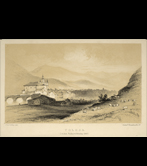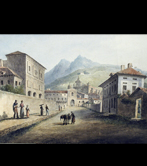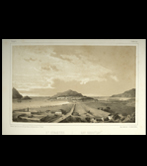Confrontation over the capital: Tolosa versus Donostia
Under the old Regime, Gipuzkoa did not have a capital, as under the system of fueros it was understood that the Diputación (provincial government) rotated between the four main villas of Donostia, Tolosa, Azpeitia and Arzkoitia. In the 19th century, the triumph of liberalism led to the establishment of a provincial system along the lines of the French model of départments, and Donostia became the capital. But after the reestablishment of the fueros system in 1844, the enmity between the provincial oligarchy and the progressive bourgeoisie in Donostia, led to the establishment of the Diputación, and with it, the capital at Tolosa.
The struggle for the capital, in other words, was further demonstration of the tensions between the rural nobles, who defended the fuero system, and Donostia which wanted to establish a liberal system. During the Francesada (war of independence), the new Napoleonic authorities made San Sebastián capital of the Government of Vizcaya, which, as well as covering Vizcaya, also included Gipuzkoa and Álava. The restoration of the absolutists led to the reestablishment of the fuero system. During the Liberal Trienio, Tolosa became the headquarters of the Diputación and a new territorial division was drawn up. However, when it was agreed in January 1822, San Sebastián was named capital of Gipuzkoa. It lasted for a year as the capital, until the new absolutist restoration returned to rotating the capital between the major villas.
With the death of Fernando VII, the First Carlist War began. A new provincial division drawn up under the Regency of María Christina, mother of Isabel II, granted capital status to Donostia. However, the Juntas ignored the order and proposed the establishment of the capital in a “central, garrisoned and fortified town such as Tolosa”. During the course of the war, San Sebastián became de facto the only possible capital for the liberal authorities. At the end of the war, there was once more argument within the Diputación, then based in Tolosa and keen to transfer the capital there, and the Donostia local authorities who insisted that the capital should be in the city with the biggest population – close to 10,000 inhabitants compared to 6,000 in Tolosa – and the highest number of taxpayers.
The struggles between moderates and progressives in the Spanish government proved decisive in settling the argument. Doing the Espartero Regency (1841-43) the progressive government favoured the Donostia proposal, but opposition from the Diputación prevented them from making a definitive decision. When the moderates came to power in 1844, Tolosa was established as the capital of Gipuzkoa by decree, a sign that the rural nobles had regained their influence in the provinces. San Sebastián had to wait until 1854 when, with the rise to power of the progressives, it was finally established as the capital.




